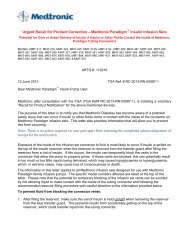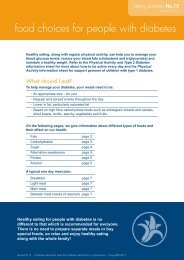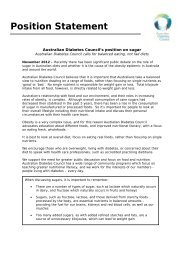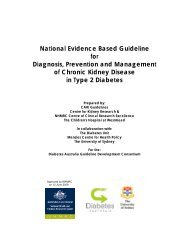Moss SE, Kle<strong>in</strong> R, Kle<strong>in</strong> BE. The 14-year <strong>in</strong>cidence <strong>of</strong> lower-extremity amputations <strong>in</strong> the diabeticpopulation. The Wiscons<strong>in</strong> Epidemiologic Study <strong>of</strong> Diabetic Ret<strong>in</strong>opathy. <strong>Diabetes</strong> Care 1999;22:951-9.Moulik PK, Mtonga R, Gill GV. Amputation <strong>and</strong> mortality <strong>in</strong> new-onset diabetic foot ulcers stratifiedby etiology. <strong>Diabetes</strong> Care 2003;26:491-4.Murray HJ, Young MJ, Hollis S, Boulton AJ. The association between callus formation, high pressures<strong>and</strong> neuropathy <strong>in</strong> diabetic foot ulceration. Diabet Med 1996;13:979-82.NSW Department <strong>of</strong> Health. Improv<strong>in</strong>g <strong>Diabetes</strong> Care & Outcomes. Pr<strong>in</strong>ciples <strong>of</strong> care <strong>and</strong> guidel<strong>in</strong>esfor the cl<strong>in</strong>ical management <strong>of</strong> diabetes mellitus v1.3. NSW Department <strong>of</strong> Health;Sydney:1996.Ohkubo Y, Kishikawa H, Araki E, Miyata T, Isami S, Motoyoshi S, Kojima Y, Furuyoshi N, ShichiriM. Intensive <strong>in</strong>sul<strong>in</strong> therapy prevents the progression <strong>of</strong> diabetic microvascular complications <strong>in</strong>Japanese patients with non-<strong>in</strong>sul<strong>in</strong>-dependent diabetes mellitus: a r<strong>and</strong>omised prospective 6 year study.<strong>Diabetes</strong> Res Cl<strong>in</strong> Pract 1995;28:103-17.Ortegon MM, Redekop WK, Niessen LW. Cost-effectiveness <strong>of</strong> prevention <strong>and</strong> treatment <strong>of</strong> thediabetic foot: A Markov analysis. <strong>Diabetes</strong> Care 2004;27:901-7.Oyibo SO, Jude EB, Tarawneh I, Nguyen HC, Armstrong DG, Harkless LB, Boulton AJ. The effects <strong>of</strong>ulcer size <strong>and</strong> site, sex <strong>and</strong> type <strong>and</strong> duration <strong>of</strong> diabetes on the outcome <strong>of</strong> diabetic foot ulcers. DiabetMed 2001;18:133-8.Quebedeaux TL, Lavery LA, Lavery DC. The development <strong>of</strong> foot deformities <strong>and</strong> ulcers after greattoe amputation <strong>in</strong> diabetes. <strong>Diabetes</strong> Care 1996;19:165-7.Pataky Z, Golay A, Faravel L, Da Silva J, Makoundou V, Peter-Riesch B, Assal JP. The impact <strong>of</strong>callosities on the magnitude <strong>and</strong> duration <strong>of</strong> plantar pressure <strong>in</strong> patients with diabetes mellitus.<strong>Diabetes</strong> Metab 2002;28:356-61.Patout CA Jr, Birke JA, Horswell R, Williams D, Cerise FP. Effectiveness <strong>of</strong> a comprehensive diabeteslower-extremity amputation prevention program <strong>in</strong> a apredom<strong>in</strong>antly low-<strong>in</strong>come African-Americanpopulation. <strong>Diabetes</strong> Care 2000;23:1339-42.Pecoraro RE, Reiber GE, Burgess EM. Pathways to diabetic limb amputation. Basis for prevention.<strong>Diabetes</strong> Care 1990;13:513-20.Perry JE, Ulbrecht JS, Derr JA, Cavanagh PR. The use <strong>of</strong> runn<strong>in</strong>g shoes to reduce plantar pressures <strong>in</strong>patients who have diabetes. J Bone Jo<strong>in</strong>t Surg 1995;77:1819-28.Peters EJ, Lavery LA. Effectiveness <strong>of</strong> the diabetic foot risk classification system <strong>of</strong> the <strong>in</strong>ternationalwork<strong>in</strong>g group on the diabetic foot. <strong>Diabetes</strong> Care 2001;24:1442-7.Pham H, Armstrong DG, Harvey C, Harkless LB, Giur<strong>in</strong>i JM, Veves A. Screen<strong>in</strong>g techniques toidentify people at high risk for diabetic foot ulceration. A prospective multicenter trial. <strong>Diabetes</strong> Care2000;23:606-11.Pieber TR, Holler A, Siebenh<strong>of</strong>er A, Brunner GA, Semlitsch B, Schattenberg S, Zapotoczky H, Ra<strong>in</strong>erW, Krejs GJ. Evaluation <strong>of</strong> a structured teach<strong>in</strong>g <strong>and</strong> treatment programme for <strong>Type</strong> 2 diabetes <strong>in</strong>general practice <strong>in</strong> a rural area <strong>of</strong> Austria. Diabet Med 1995;12:349-54.P<strong>in</strong>zur MS, Stuck R, Sage R, Pocius L, Trout B, Wolf B, Vrbos L. Benchmark analysis on diabetics athigh risk for lower extremity amputation. <strong>Foot</strong> Ankle Int 1996;17:695-700.Pitei DL, Foster A, Edmonds M. The effect <strong>of</strong> regular callus removal on foot pressures. J <strong>Foot</strong> AnkleSurg 1999;38:251-5.106
Plank J, Haas W, Rakovac I, Gorzer E, Sommer R, Siebenh<strong>of</strong>er A, Pieber TR. Evaluation <strong>of</strong> the impact<strong>of</strong> chiropodist care <strong>in</strong> the secondary prevention <strong>of</strong> foot ulcerations <strong>in</strong> diabetic subjects. <strong>Diabetes</strong> Care2003;26:1691-5.Praet SF, Louwerens JW. The <strong>in</strong>fluence <strong>of</strong> shoe design on plantar pressures <strong>in</strong> neuropathic feet.<strong>Diabetes</strong> Care 2003;26:441-5.Ragnarson Tennvall G, Apelqvist J. <strong>Prevention</strong> <strong>of</strong> diabetes-related foot ulcers <strong>and</strong> amputations: a costutilityanalysis based on Markov model simulations. Diabetologia 2001;44:2077-87.Ramsey SD, Newton K, Blough D, McCulloch DK, S<strong>and</strong>hu N, Reiber GE, Wagner EH. Incidence,outcomes, <strong>and</strong> cost <strong>of</strong> foot ulcers <strong>in</strong> patients with diabetes. <strong>Diabetes</strong> Care 1999;22:382-7.Raspovic A, Newcombe L, Lloyd J, Dalton E. Effect <strong>of</strong> customised <strong>in</strong>soles on vertical plantar pressures<strong>in</strong> sites <strong>of</strong> previous neuropathic ulceration <strong>in</strong> the diabetic foot. <strong>Foot</strong> 2000;10:133-8.Reiber GE, Pecoraro RE, Koepsell TD. Risk factors for amputation <strong>in</strong> patients with diabetes mellitus.A case-control study. Ann Intern Med 1992;117:97-105.Reiber GE, Vileikyte L, Boyko EJ, del Aguila M, Smith DG, Lavery LA, Boulton AJ. Causal pathwaysfor <strong>in</strong>cident lower-extremity ulcers <strong>in</strong> patients with diabetes from two sett<strong>in</strong>gs. <strong>Diabetes</strong> Care1999;22:157-62.Reiber GE, Smith DG, Wallace C, Sullivan K, Hayes S, Vath C, Maciejewski ML, Yu O, Heagerty PJ,LeMaster J. Effect <strong>of</strong> therapeutic footwear on foot reulceration <strong>in</strong> patients with diabetes: a r<strong>and</strong>omisedcontrol trial. JAMA 2002a;287:2552-8.Reiber GE, Smith DG, Wallace CM, Vath CA, Sullivan K, Hayes S, Yu O, Mart<strong>in</strong> D, Maciejewski M.<strong>Foot</strong>wear used by <strong>in</strong>dividuals with diabetes <strong>and</strong> a history <strong>of</strong> foot ulcer. J Rehabil Res Dev2002b;39:615-22.Rettig BA, Shrauger DG, Recker RR, Gallagher TF, Wiltse H. A r<strong>and</strong>omized study <strong>of</strong> the effects <strong>of</strong> ahome diabetes education program. <strong>Diabetes</strong> Care 1986;9:173-8.Rith-Najarian S, Branchaud C, Beaulieu O, Gohdes D, Simonson G, Mazze R. Reduc<strong>in</strong>g lowerextremityamputations due to diabetes. Application <strong>of</strong> the staged diabetes management approach <strong>in</strong> aprimary care sett<strong>in</strong>g. J Fam Pract 1998;47:127-32.Rith-Najarian SJ, Stolusky T, Gohdes DM. Identify<strong>in</strong>g diabetic patients at high risk for lower-extremityamputaion <strong>in</strong> a primary health care sett<strong>in</strong>g. A prospective evaluation <strong>of</strong> simple screen<strong>in</strong>g criteria.<strong>Diabetes</strong> Care 1992;15:1386-9.Robertson GS, Ristic CD, Bullen BR. The <strong>in</strong>cidence <strong>of</strong> congenitally absent foot pulses. Ann R CollSurg Engl 1990;72:99-100.Ronnemaa T, Hamala<strong>in</strong>en H, Toikka T, Liukkonen I. Evaluation <strong>of</strong> the impact <strong>of</strong> podiatrist care <strong>in</strong> theprimary prevention <strong>of</strong> foot problems <strong>in</strong> diabetic subjects. <strong>Diabetes</strong> Care 1997;20:1833-7.Sarnow MR, Veves A, Giur<strong>in</strong>i JM, Rosenblum BI, Chrzan JS, Habershaw GM. In-shoe foot pressuremeasurements <strong>in</strong> diabetic patients with at-risk feet <strong>and</strong> <strong>in</strong> healthy subjects. <strong>Diabetes</strong> Care1994;17:1002-6.ScHARR (School <strong>of</strong> Health <strong>and</strong> Related Research). Cl<strong>in</strong>ical guidel<strong>in</strong>es for <strong>Type</strong> 2 diabetes. <strong>Prevention</strong><strong>and</strong> treatment <strong>of</strong> diabetic foot ulcers. RCGP; London: 1999.Scottish Intercollegiate Guidel<strong>in</strong>es Network. Diabetic <strong>Foot</strong> Disease. Scottish Intercollegiate Guidel<strong>in</strong>esNetwork; Ed<strong>in</strong>burgh: 1997.Simmons D, Scott D, Kenealy T, Scragg R. <strong>Foot</strong> care among diabetic patients <strong>in</strong> south Auckl<strong>and</strong>. NZMed J 1995;108:106-8.107
- Page 1:
National Evidence Based Guidelinesf
- Page 4:
Research OfficersMs Linda SmithPodi
- Page 7 and 8:
2.2 Issues for Foot Problems in Typ
- Page 9:
• Aim to achieve the best possibl
- Page 12 and 13:
Background - Peripheral Neuropathy
- Page 14 and 15:
proportion of subjects with a durat
- Page 16 and 17:
and an OR 1.1-7.8. This study also
- Page 18 and 19:
Summary - Peripheral Neuropathy as
- Page 20 and 21:
Section 2: Diabetes Foot ProblemsIs
- Page 22 and 23:
predicting risk of amputation, 2.9
- Page 24 and 25:
Summary - Peripheral Vascular Disea
- Page 26 and 27:
Section 3: Diabetes Foot ProblemsIs
- Page 28 and 29:
Evidence - Foot Deformity and Previ
- Page 30 and 31:
people with both LJM and neuropathy
- Page 32 and 33:
Summary - Foot Deformity and Previo
- Page 34 and 35:
Section 4: Diabetes Foot ProblemsIs
- Page 36 and 37:
Also in the Seattle study, 67 peopl
- Page 38 and 39:
Summary - Ulcer as a Risk Factor fo
- Page 40 and 41:
Section 5: Diabetes Foot ProblemsIs
- Page 42 and 43:
The other frequently reported metho
- Page 44 and 45:
side; and 82% having the same resul
- Page 46 and 47:
Evidence Table: Section 5Detection
- Page 48 and 49:
Background - Clinical Detection of
- Page 50 and 51:
pulse was bilaterally absent in 1.8
- Page 52 and 53:
Evidence Table: Section 6AuthorClin
- Page 54 and 55:
Background - Frequency of Foot Exam
- Page 56 and 57: Summary - Frequency of Foot Examina
- Page 58 and 59: Section 8: Diabetes Foot ProblemsIs
- Page 60 and 61: Behaviour assessment scores, measur
- Page 62 and 63: Mazzuca et al (1986) studies 532 pe
- Page 64 and 65: with before the programme, after 1-
- Page 66 and 67: Evidence Table: Section 8AuthorEffe
- Page 68 and 69: Background - Glycaemic Control and
- Page 70 and 71: In a previous Japanese randomised s
- Page 72 and 73: Evidence Table: Section 9AuthorGlyc
- Page 74 and 75: Background - Footwear to Reduce Ulc
- Page 76 and 77: period. In addition people without
- Page 78 and 79: Comparisons of in-shoe foot pressur
- Page 80 and 81: The rate of plantar callus formatio
- Page 82 and 83: Evidence Table: Section 10AuthorFoo
- Page 84 and 85: Background - Foot Clinics and Multi
- Page 86 and 87: A prospective non randomised contro
- Page 88 and 89: Summary - Foot Clinics and Multi-di
- Page 90 and 91: Section 12: Diabetes Foot ProblemsI
- Page 92 and 93: and/or osteomyelitis; III - fore-fo
- Page 94 and 95: Summary - Economic consequences•
- Page 96 and 97: Section 13: Diabetes Foot ProblemsI
- Page 98 and 99: Some ethnic groups are associated w
- Page 100 and 101: Evidence Table: Section 13AuthorSoc
- Page 102 and 103: Calle-Pascual AL, Duran A, Diaz A,
- Page 104 and 105: Jannink MJ, van Dijk H, de Vries J,
- Page 108 and 109: Soulier SM, Godsey C, Asay ED, Perr
- Page 110 and 111: Diabetes Foot Problems: General Ref
- Page 112 and 113: McNeely MJ, Boyko EJ, Ahroni JH, St
- Page 114 and 115: Diabetes Foot Problems: Other Refer
- Page 116 and 117: Caputo GM, Cavanagh PR, Ulbrecht JS
- Page 118 and 119: Garbalosa JC, Cavanagh PR, Wu G, Ul
- Page 120 and 121: Lavery LA, Armstrong DG, Wunderlich
- Page 122 and 123: Payne C. Regional variations of dia
- Page 124 and 125: Tovi J, Svanborg E, Nilsson BY, Eng
- Page 126 and 127: Criteria used to determine the suit
- Page 128 and 129: QUESTIONS KEY WORDS NO.ARTICLESIDEN
- Page 130 and 131: QUESTIONS KEY WORDS NO.ARTICLESIDEN
- Page 132 and 133: QUESTIONS KEY WORDS NO.ARTICLESIDEN
- Page 134 and 135: QUESTIONS KEY WORDS NO.ARTICLESIDEN
- Page 136 and 137: QUESTIONS KEY WORDS NO.ARTICLESIDEN
- Page 138 and 139: QUESTIONS KEY WORDS NO.ARTICLESIDEN
















